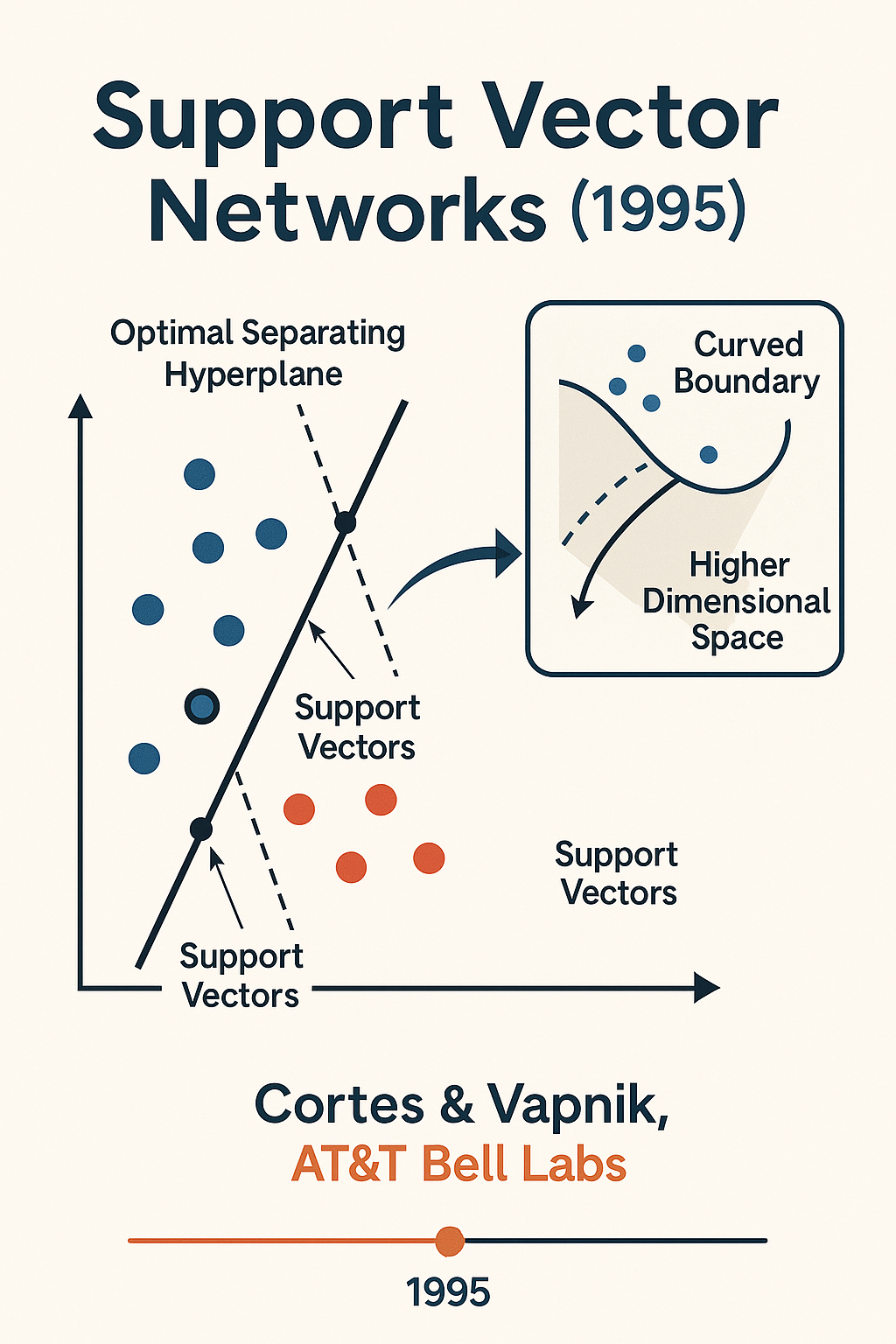Support Vector Networks: The 1995 Breakthrough That Revolutionized Machine Learning

The machine learning landscape was forever changed in 1995 when Corinna Cortes and Vladimir Vapnik published their groundbreaking paper "Support-Vector Networks" at AT&T Bell Laboratories. This foundational work introduced a revolutionary approach to classification problems that would become one of the most influential algorithms in artificial intelligence history. Unlike previous methods that often struggled with generalization and high-dimensional data, Support Vector Networks (SVMs) provided both theoretical rigor and practical effectiveness, establishing a new paradigm for machine learning that continues to impact modern AI development.
The Historical Context: AI in the 1990s
The 1990s represented a pivotal decade for artificial intelligence, marked by both significant innovations and computational limitations. During this period, machine learning researchers grappled with fundamental challenges in pattern recognition, particularly in handling complex, high-dimensional datasets. Traditional approaches like decision trees and early neural networks often failed to provide robust solutions for real-world classification problems.
At AT&T Bell Laboratories, researchers were working on practical applications like optical character recognition for the US Postal Service, requiring systems that could accurately classify handwritten digits. The computational constraints of the era demanded algorithms that were both mathematically sound and computationally efficient. It was in this context that Vapnik and his colleagues developed Support Vector Networks, drawing from decades of statistical learning theory research that began in the Soviet Union during the 1960s.
Core Innovations: Three Revolutionary Concepts
Optimal Margin Hyperplane: Beyond Simple Separation
The first major breakthrough of Support Vector Networks was the concept of the optimal margin hyperplane. Rather than simply finding any decision boundary that separates classes, SVMs seek the hyperplane that maximizes the margin between different classes. This approach ensures that the classifier not only performs well on training data but also generalizes effectively to unseen examples.
The mathematical foundation involves minimizing the norm of the weight vector while satisfying classification constraints, creating a unique optimization problem with guaranteed solutions. This margin maximization principle provides theoretical guarantees about generalization performance that were unprecedented in machine learning at the time.
The Kernel Trick: Conquering Non-Linear Problems
Perhaps the most elegant innovation was the kernel trick, which allows SVMs to handle non-linearly separable data without explicitly computing high-dimensional transformations. By using kernel functions, the algorithm can implicitly map input data into higher-dimensional feature spaces where linear separation becomes possible.
The beauty of this approach lies in its computational efficiency—instead of working in potentially infinite-dimensional spaces, the algorithm only needs to compute dot products in the original input space. Common kernels include polynomial functions K(u,v) = (u·v + 1)^d and radial basis functions, each capable of capturing different types of non-linear relationships.
Soft Margin Classification: Handling Real-World Data
The third innovation addressed the practical reality that real-world data is rarely perfectly separable1. The soft margin approach introduces a penalty parameter C that allows for some misclassifications while still maximizing the margin for correctly classified points1. This extension transforms the optimization into a more flexible framework that can handle noisy, overlapping data distributions.
Benchmark-Breaking Experimental Results
The empirical validation of Support Vector Networks demonstrated their superiority across challenging real-world tasks, particularly in handwritten digit recognition.
US Postal Service Database Performance
Using the US Postal Service database containing 7,300 training patterns and 2,000 test patterns of 16×16 pixel images, SVMs achieved remarkable results. The system reached error rates as low as 4.2% with 6th degree polynomial kernels, substantially outperforming existing methods1.
Compared to traditional approaches, the improvement was dramatic: decision trees achieved 16-17% error rates, while the best neural networks managed 6.6% errors. Even more impressive was the efficiency in terms of support vectors—higher degree polynomials required only marginally more support vectors, indicating excellent scalability1.
NIST Database Breakthrough
The larger NIST database, containing 60,000 training and 10,000 test patterns at 28×28 pixel resolution, provided an even more comprehensive evaluation. Support Vector Networks achieved a 1.1% error rate using 4th degree polynomials, establishing a new benchmark for the field.
Remarkably, this performance was achieved without domain-specific preprocessing or architectural engineering, demonstrating the universal applicability of the approach. Contemporary researchers noted that SVMs would perform equally well even if image pixels were randomly permuted, highlighting their robustness to input representation.
Theoretical Foundation: Statistical Learning Theory
VC Dimension and Generalization Control
Support Vector Networks introduced practical application of Vapnik-Chervonenkis (VC) dimension theory to machine learning. The key insight was that generalization ability depends not on the dimensionality of the input space, but on the number of support vectors relative to the training set siz.
The theoretical bound E[Pr(error)] ≤ E[number of support vectors]/number of training vectors provides unprecedented guarantees about test performance. This mathematical framework explained why SVMs could work effectively even in billion-dimensional feature spaces, as long as the number of support vectors remained small.
Structural Risk Minimization Principle
The algorithm implements the structural risk minimization principle by balancing empirical risk (training error) with model complexity. This approach provides a principled method for avoiding overfitting, unlike earlier techniques that relied primarily on heuristics.
The optimization framework ensures that SVMs naturally find the right trade-off between fitting the training data and maintaining simplicity, leading to robust generalization performance.
Real-World Applications: From Theory to Practice
Pattern Recognition and Image Classification
Support Vector Networks found immediate applications in pattern recognition tasks beyond handwritten digits. The technology proved effective for face detection, object recognition, and general image classification problems. The ability to handle high-dimensional data made SVMs particularly suitable for computer vision applications where traditional methods struggled.
Text and Document Analysis
Early adopters quickly recognized SVMs' potential for text classification and document categorization. The natural high-dimensionality of text data aligned perfectly with SVMs' strengths, leading to applications in spam filtering, sentiment analysis, and automated document sorting.
Bioinformatics and Scientific Computing
The pharmaceutical and biotechnology industries embraced SVMs for protein classification, gene analysis, and drug discovery applications. The algorithm's ability to find subtle patterns in complex biological data made it invaluable for computational biology research.
Competitive Landscape: SVMs vs. Contemporary Methods
Neural Networks: The 1990s Comparison
During the 1990s, Support Vector Networks offered significant advantages over neural networks, which were prone to overfitting and local minima problems. While neural networks required careful architecture design and extensive hyperparameter tuning, SVMs provided a more principled approach with guaranteed global optima.
The comparison was particularly stark in the handwritten digit recognition benchmarks, where SVMs consistently outperformed even specially designed neural network architectures like LeNet11. This performance gap helped establish SVMs as a preferred method for many classification tasks throughout the late 1990s and 2000s.
Traditional Machine Learning Methods
Compared to decision trees, k-nearest neighbors, and linear classifiers, SVMs demonstrated superior generalization ability and robustness. The mathematical foundation provided by statistical learning theory gave practitioners confidence in SVM predictions that was often lacking with other approaches.
Modern Relevance: SVMs in the Deep Learning Era
Enduring Applications
Despite the rise of deep learning, Support Vector Networks remain highly relevant for specific applications where interpretability, guaranteed convergence, and performance on smaller datasets are critical. Modern implementations continue to find use in domains such as financial modeling, medical diagnosis, and scientific research.
Influence on Modern AI
The principles introduced by SVMs—margin maximization, kernel methods, and convex optimization—continue to influence contemporary machine learning. Concepts from SVM theory appear in modern deep learning architectures, regularization techniques, and optimization algorithms.
Hybrid Approaches
Current research explores combining SVMs with deep learning architectures, leveraging the strengths of both approaches. These hybrid methods attempt to capture the theoretical rigor of SVMs while benefiting from deep learning's representation learning capabilities.
Implementation and Practical Considerations
Computational Efficiency
The quadratic programming formulation of SVMs enables efficient implementation through specialized solvers. Modern software libraries like scikit-learn provide optimized implementations that make SVMs accessible to practitioners across various domains.
Hyperparameter Selection
Success with SVMs depends critically on proper selection of kernel functions and regularization parameters. Cross-validation techniques and grid search methods have become standard approaches for optimizing SVM performance.
Scalability Challenges
While SVMs excel on moderately sized datasets, they face computational challenges with very large datasets that have become common in the big data era. This limitation has driven interest in approximation methods and distributed implementations.
The Lasting Legacy of Support Vector Networks
Scientific Impact
The 1995 Support Vector Networks paper has become one of the most cited works in machine learning history, fundamentally changing how researchers approach classification problems. The theoretical framework provided by Vapnik and Cortes established machine learning as a more rigorous mathematical discipline.
Educational Influence
SVMs have become a cornerstone of machine learning education, providing students with insights into optimization theory, statistical learning, and the bias-variance trade-off. The clear mathematical formulation makes SVMs an excellent pedagogical tool for understanding fundamental machine learning concepts.
Industrial Adoption
Major technology companies quickly adopted SVM technology for production systems, leading to widespread industrial applications throughout the 2000s. The reliability and theoretical guarantees of SVMs made them attractive for mission-critical applications.
Future Directions and Ongoing Research
Theoretical Extensions
Research continues into extending SVM theory to new domains, including multi-class classification, regression problems, and structured prediction tasks. Theoretical work on understanding when and why SVMs work well remains an active area of investigation.
Algorithmic Improvements
Modern research focuses on developing more efficient training algorithms, better kernel functions, and improved methods for handling very large datasets. Online learning variants and streaming algorithms represent promising directions for SVM development.
Integration with Modern AI
The integration of SVM principles with contemporary AI techniques, including ensemble methods and neural architectures, continues to yield practical improvements. This hybrid approach may represent the future evolution of SVM technology.
Conclusion: A Foundation That Endures
Support Vector Networks represent more than just another machine learning algorithm—they embody a fundamental shift toward mathematically principled approaches to artificial intelligence. The 1995 paper by Cortes and Vapnik not only solved practical classification problems but also established theoretical foundations that continue to influence machine learning research today.
The three core innovations—optimal margin hyperplanes, kernel methods, and soft margin classification—provided the field with tools that remain relevant thirty years later1. While deep learning has captured much attention in recent years, the fundamental insights from SVM theory continue to inform best practices in model design, optimization, and generalization.
For practitioners and researchers in the AI community, understanding Support Vector Networks provides crucial insights into the mathematical foundations of machine learning. The principles of margin maximization, convex optimization, and statistical learning theory established by this work remain essential knowledge for anyone serious about developing robust, reliable AI systems.
As we continue to push the boundaries of artificial intelligence, the rigorous theoretical framework and practical effectiveness demonstrated by Support Vector Networks serve as a reminder that the most powerful innovations often come from the marriage of mathematical elegance and real-world applicability. The legacy of this groundbreaking 1995 paper continues to shape how we approach machine learning challenges, proving that truly fundamental contributions to science have an enduring impact that transcends technological trends.
This summary is created by www.best-ai-tools.org copyright BitAutor 2025
https://techbullion.com/artificial-intelligence-in-the-90s-a-decade-of-innovation-and-challenges/
https://coe-379l-sp24.readthedocs.io/en/latest/unit04/ml_benchmarks.html
https://people.idsia.ch/~juergen/deep-learning-miraculous-year-1990-1991.html
https://en.wikipedia.org/wiki/Vapnik%E2%80%93Chervonenkis_dimension
https://mldemystified.com/posts/basics-of-ml/support-vector-machines/svm-kernel-machines/
https://www.numberanalytics.com/blog/mathematics-behind-structural-risk-minimization
https://www.mathworks.com/matlabcentral/fileexchange/48567-usps-digit-dataset
https://www.numberanalytics.com/blog/svm-applications-in-modern-ai
https://www.numberanalytics.com/blog/svm-vs-deep-learning-6-differences
https://www.spiceworks.com/tech/big-data/articles/what-is-support-vector-machine/
https://web.engr.oregonstate.edu/~huanlian/teaching/ML/2017fall/extra/svn-1995.pdf
http://forohistorico.coit.es/index.php/biblioteca/articulos-seminales/item/support-vector-networks
https://keylabs.ai/blog/support-vector-machines-svm-fundamentals-and-applications/
https://www.sciencedirect.com/science/article/abs/pii/S0893608009001130
https://www.sciencedirect.com/science/article/abs/pii/S0893608022000405
https://mlsysbook.ai/contents/core/benchmarking/benchmarking.html
Recommended AI tools
DeepL
Writing & Translation
The world’s most accurate AI translator
GitHub Copilot
Code Assistance
Your AI pair programmer and autonomous coding agent
Google Cloud Vertex AI
Data Analytics
Unified AI and cloud for every enterprise: models, agents, infrastructure, and scale.
JanitorAI
Conversational AI
Create, customize, and chat with uncensored AI characters—complete creative freedom and control
Adobe Firefly
Image Generation
Create your way with Adobe Firefly—AI for every creative vision.
Azure Machine Learning
Data Analytics
Enterprise-ready AI for every step of your machine learning journey


